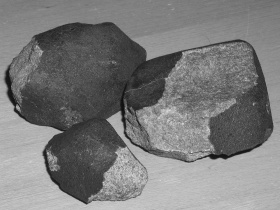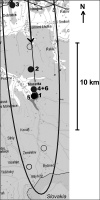(Unless otherwise stated, the copyright of the materials included belong to Jan Woreczko & Wadi.)
Morávka
Z Wiki.Meteoritica.pl
(→Linki zewnętrzne) |
|||
| Linia 85: | Linia 85: | ||
* '''Meteoritical Bulletin Database ([http://www.lpi.usra.edu/meteor/metbull.php MBD])''' - meteoryt [http://www.lpi.usra.edu/meteor/metbull.php?code=16742 Morávka] | * '''Meteoritical Bulletin Database ([http://www.lpi.usra.edu/meteor/metbull.php MBD])''' - meteoryt [http://www.lpi.usra.edu/meteor/metbull.php?code=16742 Morávka] | ||
* '''Encyclopedia of Meteorites ([http://www.encyclopedia-of-meteorites.com/ EoM])''' - meteoryt [http://www.encyclopedia-of-meteorites.com/meteorite.aspx?id=16742 Morávka] | * '''Encyclopedia of Meteorites ([http://www.encyclopedia-of-meteorites.com/ EoM])''' - meteoryt [http://www.encyclopedia-of-meteorites.com/meteorite.aspx?id=16742 Morávka] | ||
| + | |||
* METEORITE ACTION! - dane o orbicie meteoroidu, bolidzie (fotografie i nagrania video) i znaleziskach meteorytu [http://fireball.meteorite.free.fr/meteor/en/3/2000-05-06/moravka/data Morávka] | * METEORITE ACTION! - dane o orbicie meteoroidu, bolidzie (fotografie i nagrania video) i znaleziskach meteorytu [http://fireball.meteorite.free.fr/meteor/en/3/2000-05-06/moravka/data Morávka] | ||
* Fotografie trzech pierwszych okazów http://www.asu.cas.cz/~borovic/meteorit.htm | * Fotografie trzech pierwszych okazów http://www.asu.cas.cz/~borovic/meteorit.htm | ||
Wersja z 17:46, 16 cze 2011
Niewiele brakowało, a spadłby w Polsce
| Morávka → | |

Trzy pierwsze znaleziska, 214 g (lewy), 330 g (prawy) i 91 g (dolny) (fot. Borovička 2003)
| |
| Spadek | |
| Lokalizacja | Czechy |
| Położenie[1] | 49°36'N, 18°32'E |
| Data | 6 maj 2000 r., 11:51:52 UT |
| Uwagi | jest wysoce prawdopodobne, że nie zebrano wszystkich okazów |
| Charakterystyka | |
| Typ | chondryt zwyczajny, H5 |
| Masa | 1400 g |
| Liczba okazów | 6 okazów |
| Meteoritical Bulletin Database | |
Spadek meteorytów w Czechach po efektownym bolidzie z 6 maja 2000 roku. Początek spektaklu, bolid miał jasność -20m, rozpoczął się nad południową Polską, ale meteoryty z niego spadły na terenie Czech w okolicy miejscowości Morávka (Morawka).
Bolid widziany z terenu Czech, Polski i Słowacji leciał z północy, uległ dużej fragmentacji. Znaleziono w sumie tylko sześć okazów o łącznej masie 1399,3 g. W wielu miejscach słyszano odgłosy spadających kamieni, ale nic tam nie znaleziono!
Lista okazów i ich współrzędne znalezienia[2].
Table 1. Coordinates of the recovered meteorites from the Morávka fall. # Date of recovery Mass [g] Longitude East Latitude North 1 May 6, 2000 214.2 18°32'26.6" 49°35'02.8" 2 May 13, 2000 329.5 18°32'00.4" 49°36'40.5" 3 end of May, 2000 90.6 18°30'14.9" 49°40'39.8" 4 May 13, 2000 235.1 18°32'17.4" 49°35'25.9" 5 July 31, 2001 229.1 18°32'16.6" 49°35'00.8" 6 May 12, 2000 300.8 18°32'18.6" 49°35'28.2"
Bolid zarejestrowały stacje bolidowe sieci European Fireball Network (EN). Otrzymał on oznaczenie EN060500.
- Abstrakt pracy Borovička et al. 2003[3]
- The Morávka (Czech Republic) meteorite fall occurred on May 6, 2000, 11:52 UT, during the daytime. Six H5-6 ordinary chondrites with a total mass of 1.4 kg were recovered. The corresponding fireball was witnessed by thousands of people and also videotaped by 3 casual witnesses. Sonic booms were recorded by 16 seismic stations in the Czech Republic and Poland and by one infrasonic station in Germany. A total of 2.5% of the fireball eyewitnesses reported electrophonic sounds. Satellites in Earth orbit detected part of the fireball light curve.
- In this first paper from a series of 4 papers devoted to the Morávka meteorite fall, we describe the circumstances of the fall and determine the fireball trajectory and orbit from calibrated video records. Morávka becomes one of only 6 meteorites with a known orbit. The slope of the trajectory was 20.4 deg to the horizontal, the initial velocity was 22.5 km/s, and the terminal height of the fireball was 21 km. The semimajor axis of the orbit was 1.85 AU, the perihelion distance was 0.982 AU, and the inclination was 32.2 deg. The fireball reached an absolute visual magnitude of -20 at a height of 33 km.
Lokalizacja
miejsca znalezienia okazów
Bolid leciał od północy pod bardzo małym kątem do horyzontu około 20°.
Teren spadku jest górzysty i trudny dla poszukiwań. Z rozkładu znalezionych okazów i wyliczonego obszaru spadku (elipsy) wynika, że są tam jeszcze szanse na znalezienie okazów nawet kilkukilogramowych!
Galeria
Położenie znalezionych okazów (pełne kółka) i miejsc (puste kółka), w których słyszano charakterystyczny odgłos upadających kamieni, ale nie znaleziono okazów.[2] |
Bibliografia
- +Borovička Jiří, Spurný Pavel, Kalenda Pavel, et al, (2003), The Morávka meteorite fall: 1. Description of the events and determination of the fireball trajectory and orbit from video records. 2. Interpretation of infrasonic and seismic data. 3. Meteoroid initial size, history, structure, and composition. 4. Meteoroid dynamics and fragmentation in the atmosphere. Meteoritics & Planetary Science, vol. 38, no 7, 2003, s. 975–1043. Plik adsabs
- +Pilski Andrzej S., (2000), Meteoryt, który przeleciał nam koło nosa. Meteoryt, 2, 2000, s. 11.
Przypisy
- ^ jeśli nie zaznaczono inaczej, podano współrzędne przyjęte w oficjalnej bazie meteorytów Meteoritical Bulletin Database
- ^ a b Borovička et al. 2003
- ^ szczegółowe wyniki zostały opublikowane w artykułach Borovička et al. (2003), The Morávka meteorite fall: part1 | part2 | part3 | part4
Linki zewnętrzne
- Meteoritical Bulletin Database (MBD) - meteoryt Morávka
- Encyclopedia of Meteorites (EoM) - meteoryt Morávka
- METEORITE ACTION! - dane o orbicie meteoroidu, bolidzie (fotografie i nagrania video) i znaleziskach meteorytu Morávka
- Fotografie trzech pierwszych okazów http://www.asu.cas.cz/~borovic/meteorit.htm
- European Fireball Network (EN) - Sieci bolidowe
